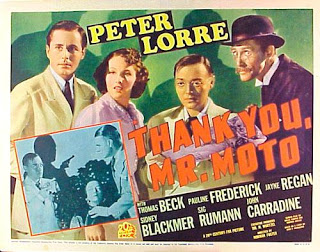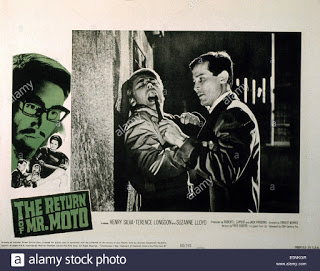In 1933 at the age of 49 author Earl Derr Biggers unexpectedly died and brought
the Charlie Chan series to an end though the films were to go on for many
more years. In an era of xenophobia by much of America – and much of it in
particular targeted at Asians – Chan had somehow struck a congenial chord
and had become enormously popular. At that time pulp novels were often first
serialized in magazines and the Charlie Chan books had appeared in the Saturday
Evening Post to much fanfare and so after Biggers’s death, the magazine went
in search of a new Asian literary hero and found him in the works of an upper
crust New Englander.
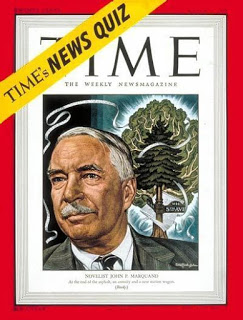
John P. Marquand came from good breeding as they would say in those days
– his cousin was Buckminister Fuller – and he went to Harvard where he wrote
for the Harvard Lampoon. After graduating he served in Europe during WW I
and after coming home he began his writing career. Marquand was to become
a well-known very respected writer in his lifetime – winning the Pulitzer
Prize in 1938 for The Late George Apley and his 1941 novel H.M. Pulham Esquire
received great critical recognition. But before and during these books that
looked with a jaundiced cynical eye on the lives of the upper class and those
aspiring to it, he created an Asian character for the Saturday Evening Post
who was to become in its time almost as iconic as Charlie Chan; Mr. Moto.
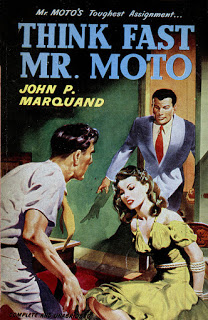
Marquand was to write six Mr. Moto novels; five before WWII and one much
later in 1957. The first one was serialized in 1935. 20th Century Fox was
to make eight Mr. Moto films starring Peter Lorre between 1937 and 1939.
Of course, there was a major issue with both the books and the films as WWII
appeared on the horizon – Mr. Moto was Japanese and it became increasingly
harder to portray a hero of a country that the USA was on a collision course
with. Mr. Moto was to disappear for a lengthy period of time until the films
began to be shown again on TV decades later. His portrayal by the chameleon
Peter Lorre, who was the Heinz 57 varieties of actor playing all types of
ethnicities in his long career, generated a whole new batch of fans. Today
you can get the whole series in a DVD package.
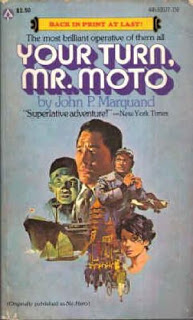
Lorre is one of my favorite character actors who did on occasion get the
lead – as in these Moto films and in the terrific Eric Ambler adaptation,
The Mask of Dimitrios – with memorable co-starring roles in The Maltese Falcon,
Casablanca, Arsenic and Old Lace and Beat the Devil. But of course he started
as an actor in Germany – his birth name is Laslzo Lowenstein - of Hungarian
descent – Jewish – born in what today is Slovakia. He had astonishingly expressive
eyes that could go from playful to psychotic in a heartbeat and these were
used to great effect when he played the serial killer in M (1931) that became
an international hit. Being Jewish he had the acuity to leave Germany in
1934 for Hollywood.
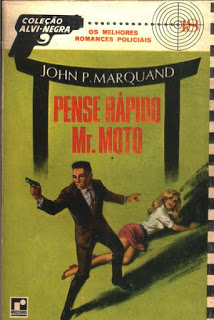
The Moto films are I expect considered B films – small budgets, no big stars
but often a solid group of character actors, routine scripts, a running time
of about 70 minutes – but Lorre is great in them and dominates the screen
even at his height of 5’3’’. Menacing at times, mischievous at others, a
master of disguise and accents - and at this point in his life before he
later pushed towards corpulence he was remarkably physically adroit with
his judo and acrobatics. Mr. Moto works for an International Government Crime
organization always flashing his card that gets him immediate respect and
co-operation whether he is in the jungles of Laos or Shanghai or Egypt. He
tackles and up ends gangs set to commit assassinations (Mysterious Mr. Moto),
stops Asian uprisings intent on driving out the white man (Mr. Moto Takes
a Chance), thwarting saboteurs planning to blow up naval ships (Mr. Moto’s
Last Warning), seeking the treasure of Genghis Khan (Thank You, Mr. Moto),
smugglers (Think Fast, Mr. Moto and Mr. Moto in Danger Island), various thieves
trying to steal the Crown of Sheba (Mr. Moto Takes a Vacation) and even stepping
into a Charlie Chan script and solving a murder (Mr. Moto’s Gamble). For
the most part Mr. Moto shows no particular allegiance to Japan and the plots
rarely edge into the world events that were already occurring at the time.
How very different in fact from the books.
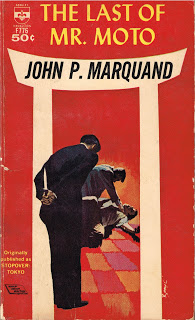
In reality the only things that the movie Moto has in common with Marquand’s
Moto are his name and his nationality. 20th Century Fox changed everything
else for American consumption. Looking back, it is quite surprising that
the Mr. Moto of the books was popular because at least in the first two novels
that I have read (Your Turn Mr. Moto (1935) and Thank You Mr. Moto - 1936)
Moto is a Japanese agent in the employ of the Emperor with very much an expansionist
agenda that he is working towards. In Thank You Mr. Moto he has a discussion
with an American and argues that Japan is rightfully doing just what other
imperialistic nations have done – acquired other areas for resources and
power. In the first novel, the main Western character is already wondering
if Japan and the USA will go to war. For some context, Japan had invaded
Manchuria in 1931 and the second Sino-Japanese war began in 1937.
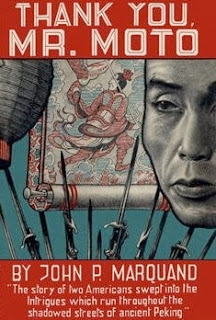
One of the peculiar things about the Moto novels is that Mr. Moto is rarely
in them – playing instead a role in the shadowy background who appears from
time to time to push his agenda with intimidation, force or murder. In both
these books, the protagonist is an American ex-pat living in Asia who has
left his identity as an American behind him and taken on the role of a jaded
uncaring internationalist. The events in the books force them to come to
terms with who they are and to redeem themselves for the woman they love.
In Your Turn Mr. Moto an ex-WWI heroic fighter pilot turned drunk agrees
to spy on the Americans and goes from Tokyo to Shanghai before he changes
his mind and has Mr. Moto try and kill him on a few occasions. In Thank You
Mr. Moto an ugly American ex-pat living in Peking gets involved in a plot
where the Japanese are working with a Chinese warlord to cause havoc in the
city. Moto is a complete professional – kill when it is necessary but only
then.
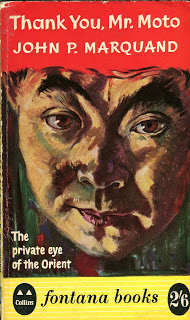
The books are very well-written for this sort of genre – thoughtful, suspenseful,
with admittedly stereotyped Asian characters but culturally knowledgeable
and perceptive about the life of ex-pats overseas. This one bit caught my
attention “One could not help wondering what force of circumstance had gathered
these dancers (ex-pats) together, strangers in a strange land from every
end of the earth. Some had run from disillusion only to find more of it.
Some had run to escape disgrace and probably found that running did no good.
Some of us had come seeking something new and there was nothing new. But
there was one thing which we all had in common – a certain dangerous initiative,
not possessed by our countrymen at home”.
Think Fast, Mr.
Moto (1937) – 6/10
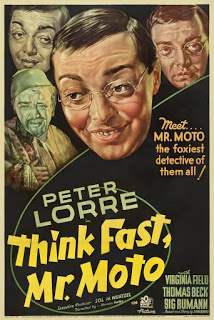
This is the first in the Mr. Moto film series (and is one of the titles of
Marquand’s books but that is the only similarity) and it gets off to a quick
start with Mr. Moto (Peter Lorre) disguised as a rug peddler in San Francisco’s
Chinatown during Chinese New Year. He discovers a dead body but instead of
informing the police he books a ticket for Shanghai. He is trying to run
down a smuggling ring who are using a shipping company as their means of
transporting illicit goods. The head of this gang comes in the unlikely form
of Sig Ruman who I have seen in so many comedies that it is a bit hard taking
him seriously. The femme fatale is played by Virginia Field who showed up
in two future Mr. Moto films as different characters.
This has a few pluses going for it. Shanghai for one though obviously not
really Shanghai. White Russians and dangerous streets where people keep trying
to kill Moto. There is one great scene of Moto using his jujitsu skills and
tossing a fellow around the room and eventually cold bloodedly throws him
to his death on purpose – much like the book Moto would do without a shred
of remorse. Moto’s assistant is the interesting Lotus Long who was
of Japanese descent and appeared in a few films during the 1930’s – in two
Moto films and three Mr. Wong (played by Boris Karloff) films. In this film
Moto says he is the head of an exporting company which is being hurt by the
smuggling and that detecting is just a hobby. In other films his profession
varies.
Thank You, Mr.
Moto (1937) – 6/10
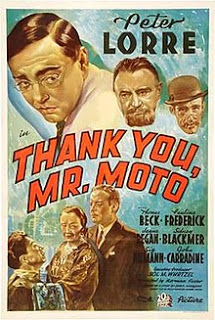
Mr. Moto is back in the second film in the series. This is more of an adventure
with Moto being hired to look for seven Chinese scrolls that will lead to
the treasure of Genghis Khan. That sounds a bit silly admittedly but it all
plays out in tense and rapid time. It begins with him in the disguise of
a camel jockey on a caravan in the Gobi desert but after killing one fellow
and being chased by the police he is once again the urbane and in this one
slightly sinister Mr. Moto living in Peking. Another gang is after the scrolls
and two innocent Americans are caught in between as are a Chinese mother
and son (Philip Ahn) who have some of the scrolls. Lorre has some good moments
as Mr. Moto in this – his usual jujitsu comes into play but even more so
his ability to make Moto an ambivalent character who at times can be quite
cold and scary. Also appearing is John Carradine as the less than honest
antique seller, Sig Ruman returns from the previous film and Thomas Beck
who had been the male romantic lead in Think Fast Mr. Moto is also back in
a similar role. That made me curious about him. Turns out he had an interesting
life – an actor, a poet, a painter, a pianist, a trained engineer, a Major
in the US Army during the war, an advertising executive and a open homosexual.
He left acting in 1939 after Fox would not raise his salary. He also was
in four Charlie Chaplin films.
Mr. Moto’s Gamble
(1938) – 5/10
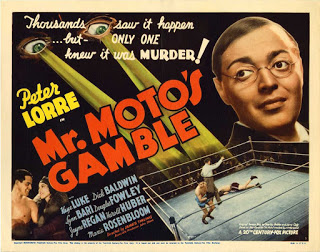
Not a lot to recommend this one due to the origin of the film as mentioned
in the other reviews. Maybe Charlie Chan would have fit better but having
Mr. Moto do Charlie Chan, aphorisms and all, just feels disappointing. This
is the third film in the Moto series and after the first two in which Moto
is at times calmly homicidal this is a weak sister. Still a nice supporting
cast with Luke Keye as Charlie Chan's son, Ward Bond who was within a few
years able to find his true genius in Westerns, Perry White - I mean John
Hamilton, Lynn Bari who shows up in so many films in that period and of course
Maxie Rosenbloom whose voice and accent are unforgettable and who had over
200 professional fights in the ring.
Mr. Moto Takes
a Chance (1938) – 5.5/10
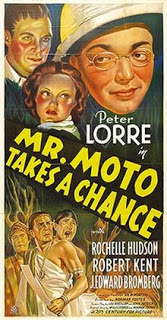
A slight improvement over the previous film Mr. Moto Gambles, but still not
close to the first two in the series. Putting Moto into a jungle environment
just feels shoddy as if they were able to borrow the Tarzan sets from MGM
for a few weeks. The fly over of Angkor Wat - one of my favorite places in
the world - was rather cool though as this film takes place in what I think
was Laos - on the map it seemed just north of the ancient city of Luang Prabang
- at the time a French colony. Moto is a sleek cool at times cruel detective/spy
who just feels more at home in the urban jungle. This sets him apart from
most film heroes of the time. At one point he seems quite willing to see
one of the Western comedy relief guys killed in order to protect his identity.
This is about a native rebellion to oust the foreigners from Asia - Tarzan
had a similar plot in one of his Weissmuller films - and now some 75 years
later I guess we are suppose to root for the imperialists but it isn't easy.
Also, how they plan on wiping out the white men with only enough guns to
fill a basement is hard to see. You have to wonder if George Lucas saw this
as a kid on TV and got his inspiration for Yoda from Lorre dressed as an
old wizened holy man. Maybe somewhere in the back of his consciousness because
seeing Lorre flying around and tackling people twice his diminutive size
sure looked like Yoda.
Mysterious Mr.
Moto (1938) – 7/10
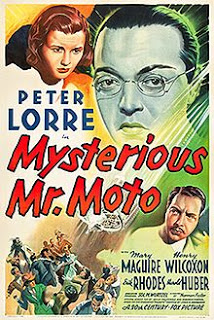
In this fifth outing in the Mr. Moto series, Moto is back in fine form
after having to substitute for Charlie Chan in the 3rd and then being exiled
to the jungles of Laos in the 4th. Here he goes from an escape in Devil's
Island to the foggy dangerous streets of London trying to stop a League of
Assassination. Quickly paced and good narrative.
It has a solid group of B actors that you come across often in these types
of films - lots of familiar faces. It was also good to see Mr. Moto's seductive
assistant back after last seeing her shot in the back in the first film in
the series, played by Lotus Long. Lotus Long was part Japanese and part Hawaiian
and also appears a few of the Mr Wong series with Karloff. She played Tokyo
Rose in the 1946 film Tokyo Rose.
Mr. Moto’s Last
Warning (1939) – 6/10
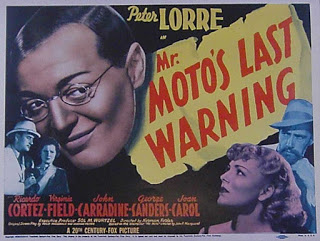
A good supporting cast gives this 6th film in the series a nice lift. George
Sanders right before he landed his Saint roles plays a polite French saboteur,
John Carradine a spy, the ubiquitous Virginia Fields who had been in Think
Fast Mr. Moto as a totally different character and Ricardo Cortez in his
typical villain role.
This was made in 1939 when the world sat on the edge of the precipice that
it soon fell into and this film certainly edges very much into that as an
unnamed country is doing its best to cause a rift between England and France.
Of course what is left unsaid is that Japan was also very much into this
mess and that was what was to undo the Moto series very soon. It was hard
having a Japanese hero when Japan itself was in the midst of its conquests
that were clearly against the interest of the USA.
Still this is a solid spy yarn and I appreciate that good guys die and that
Moto not only doesn't save them but doesn't even show any grief - this is
what his business is about.
Mr. Moto in Danger
Island (1939) – 6/10
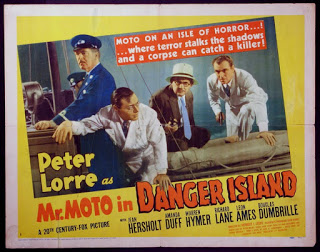
By this time the Mr. Moto series is winding down as it was getting
a bit iffy having a Japanese detective as the hero in a film. World events
were overtaking the films and the books of Mr. Moto. Though this was produced
in 1939, these events are not even a shadow on the narrative. Moto is after
diamond smugglers in Puerto Rico and a long list of suspects could be the
top dog.
It is a decent though not particularly inspiring Moto film. The best moments
probably take place right at the beginning when he flips Ward Bond as a professional
wrestler a few times - Bond had been a boxer in Mr. Moto's Gamble. He was
soon to become a regular and well-known character actor in many a Western
often with his drinking buddy John Wayne.
Another one of the cast is Jean Hersholt who was another well respected character
actor back then appearing in over 100 films - but his name is probably most
familiar today for an award that is always announced at the Oscars - The
Jean Hersholt Humanitarian Award. He plays Sutter in the film.
Mr. Moto Takes
a Vacation (1939) – 6/10
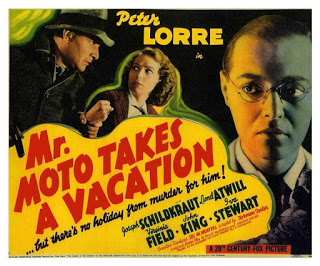
A bit too much comic relief in this final entry in the Mr. Moto series, even
bringing in black comic Willie Best for a bit, but still a fairly solid mystery
with a couple gangs trying to steal the Crown of Sheba. It was 1939 and war
was coming to Europe and Japan was invading China, so Mr. Moto quickly found
himself to be a relic of another age.
As in all the Moto films it is really Peter Lorre that you tune in for more
than the stories. He is great fun to watch though obviously the films are
below his acting talent but he seems to give it all he has and it was certainly
better than being back in Germany for this Jewish actor.
Also of interest to perhaps no one but me, but Virginia Field shows up as
the blonde in her third Moto films, all as different characters. There was
one more Mr. Moto film made in 1965 starring Henry Silva as Mr. Moto called
The Return of Mr. Moto but I have never seen this.
